外研版必修第三册Unit 4 Amazing Art Developing ideas 阅读课课件(共52张PPT)
文档属性
| 名称 | 外研版必修第三册Unit 4 Amazing Art Developing ideas 阅读课课件(共52张PPT) |  | |
| 格式 | zip | ||
| 文件大小 | 530.7KB | ||
| 资源类型 | 教案 | ||
| 版本资源 | 外研版(2019) | ||
| 科目 | 英语 | ||
| 更新时间 | 2020-06-13 19:55:14 | ||
图片预览

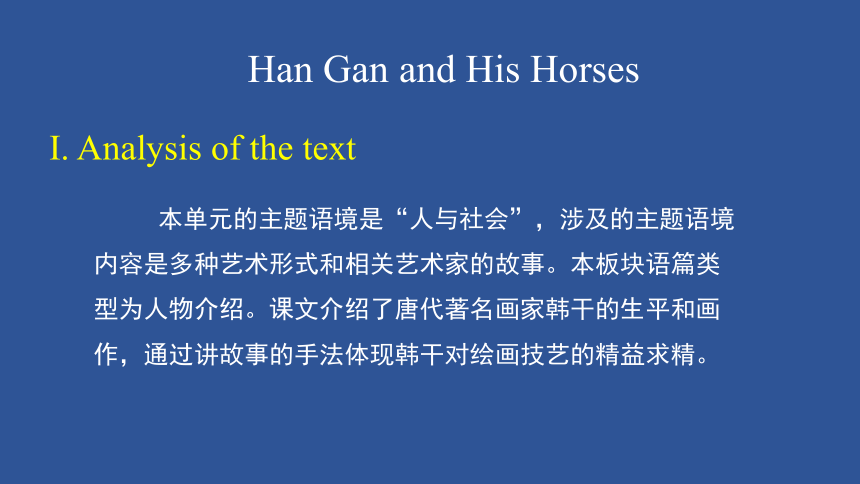
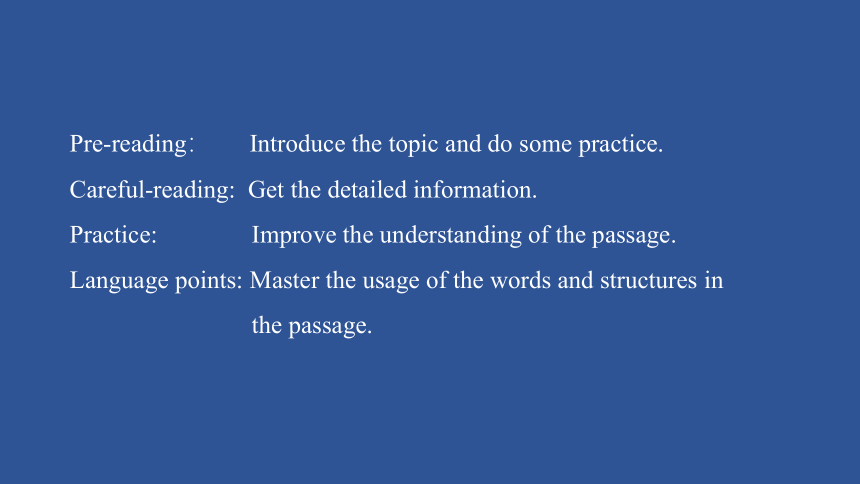
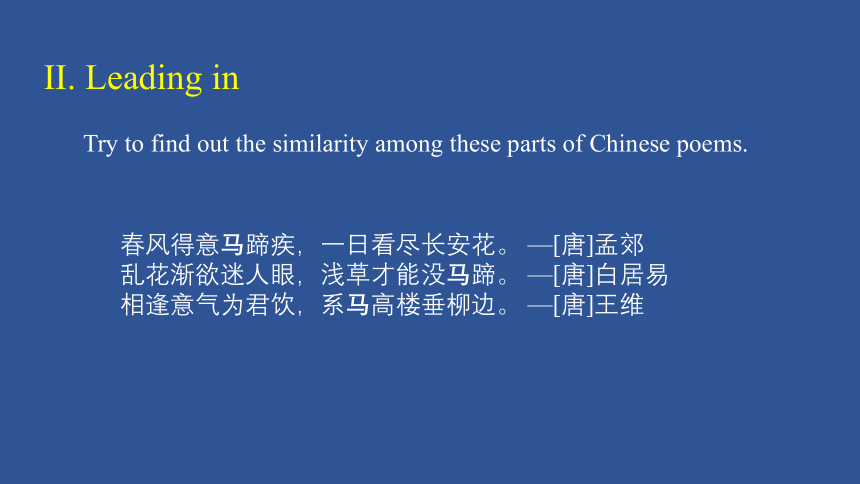
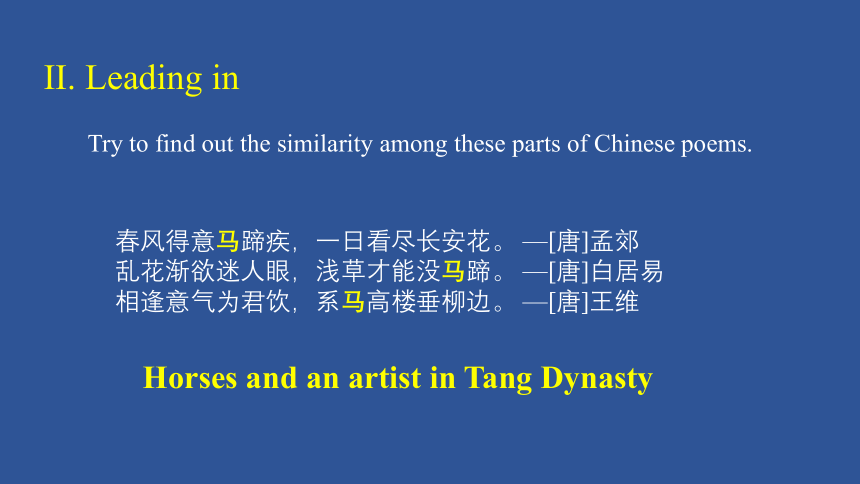



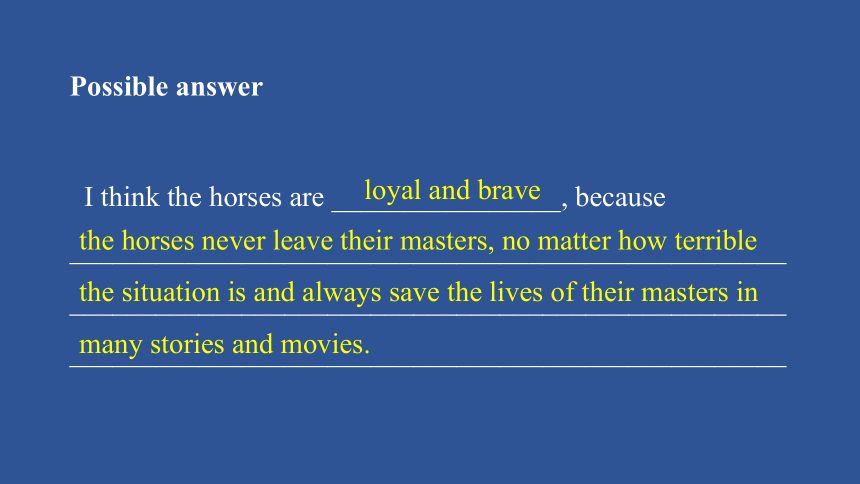


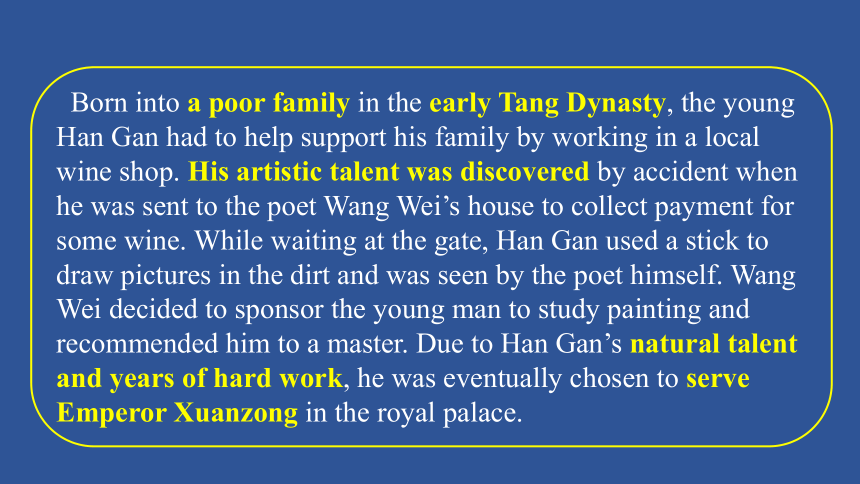
文档简介
(共52张PPT)
第三册
第4单元
Developing
ideas
阅读课
高一年级
英语
Han
Gan
and
His
Horses
I.
Analysis
of
the
text
本单元的主题语境是“人与社会”,涉及的主题语境内容是多种艺术形式和相关艺术家的故事。本板块语篇类型为人物介绍。课文介绍了唐代著名画家韩干的生平和画作,通过讲故事的手法体现韩干对绘画技艺的精益求精。
Pre-reading:
Introduce
the
topic
and
do
some
practice.
Careful-reading:
Get
the
detailed
information.
Practice:
Improve
the
understanding
of
the
passage.
Language
points:
Master
the
usage
of
the
words
and
structures
in
the
passage.
II.
Leading
in
Try
to
find
out
the
similarity
among
these
parts
of
Chinese
poems.
春风得意马蹄疾,一日看尽长安花。
—[唐]孟郊
乱花渐欲迷人眼,浅草才能没马蹄。
—[唐]白居易
相逢意气为君饮,系马高楼垂柳边。
—[唐]王维
II.
Leading
in
春风得意马蹄疾,一日看尽长安花。
—[唐]孟郊
乱花渐欲迷人眼,浅草才能没马蹄。
—[唐]白居易
相逢意气为君饮,系马高楼垂柳边。
—[唐]王维
Horses
and
an
artist
in
Tang
Dynasty
Try
to
find
out
the
similarity
among
these
parts
of
Chinese
poems.
Han
Gan
and
His
Horses
III.
Learning
1.
Tick
the
words
that
you
would
use
to
describe
horses.
Add
any
more
you
can
think
of.
□
calm
□
cute
□
fast
□
wild
□
brave
□
clever
□
loyal
□
strong
Possible
answer
I
think
the
horses
are
________________,
because
__________________________________________________
__________________________________________________
__________________________________________________
Han
Gan
and
His
Horses
III.
Learning
1.
Tick
the
words
that
you
would
use
to
describe
horses.
Add
any
more
you
can
think
of.
□
calm
□
cute
□
fast
□
wild
□
brave
□
clever
□
loyal
□
strong
Possible
answer
I
think
the
horses
are
________________,
because
__________________________________________________
__________________________________________________
__________________________________________________
loyal
and
brave
the
horses
never
leave
their
masters,
no
matter
how
terrible
the
situation
is
and
always
save
the
lives
of
their
masters
in
many
stories
and
movies.
2.
Read
the
passage
and
find
out
what
it
is
about.
An
introduction
to
the
Metropolitan
Museum
of
Art.
The
story
behind
Night-Shining
White.
The
famous
artist
Han
Gan.
What
a
magnificent
horse!
Even
after
more
than
a
thousand
years
have
passed,
we
can
still
feel
the
power
within
its
burning
eyes,
bared
teeth
and
kicking
hooves,
Night-Shining
White,
now
kept
in
New
York’s
Metropolitan
Museum
of
Art,
is
regarded
as
one
of
the
most
significant
horse
paintings
in
the
history
of
Chinese
art.
Its
artist,
Han
Gan,
is
known
for
his
skill
in
capturing
not
only
the
physical
features
of
the
animal,
but
also
its
inner
spirit
and
strength.
2.
Listen
to
the
audio
and
catch
the
general
idea
of
the
passage.
Born
into
a
poor
family
in
the
early
Tang
Dynasty,
the
young
Han
Gan
had
to
help
support
his
family
by
working
in
a
local
wine
shop.
His
artistic
talent
was
discovered
by
accident
when
he
was
sent
to
the
poet
Wang
Wei’s
house
to
collect
payment
for
some
wine.
While
waiting
at
the
gate,
Han
Gan
used
a
stick
to
draw
pictures
in
the
dirt
and
was
seen
by
the
poet
himself.
Wang
Wei
decided
to
sponsor
the
young
man
to
study
painting
and
recommended
him
to
a
master.
Due
to
Han
Gan’s
natural
talent
and
years
of
hard
work,
he
was
eventually
chosen
to
serve
Emperor
Xuanzong
in
the
royal
palace.
The
Tang
emperors
were
very
fond
of
horses.
This
meant
that
the
animal
was
a
frequent
subject
for
artists.
At
that
time,
the
most
common
way
to
study
horse
painting
was
by
copying
the
works
of
previous
painters.
Han
Gan’s
method,
however,
was
different
–
he
observed
the
animal
itself.
He
was
a
frequent
visitor
to
the
royal
stables
and
even
moved
in
to
live
with
the
stable
workers
for
quite
some
time.
The
horses,
whether
resting
or
on
the
move,
offered
him
plenty
of
inspiration.
The
more
time
he
spent
observing
these
animals,
the
more
his
understanding
of
them
grew.
Day
after
day,
Han
Gan
painted
the
horses,
his
brush
presenting
every
detail
that
he
saw
with
his
own
eyes.
It
is
said
that
when
the
Emperor
asked
Han
Gan
to
take
a
master
of
horse
painting
as
his
teacher,
the
artist
replied,
“I
have
my
own
teachers,
Your
Majesty.
All
the
horses
in
your
stables
are
my
very
teachers.”
Those
who
saw
Han
Gan’s
horse
paintings
all
sang
high
praises
for
his
unique
skill,
saying
that
his
horses
“could
gallop
off
the
paper”.
Even
Su
Shi,
the
famous
poet
of
the
Song
Dynasty,
expressed
his
admiration
for
Han
Gan
as
a
master
of
horse
painting
with
the
words,
“The
horses
painted
by
Han
Gan
are
real
horses.”
What
a
magnificent
horse!
Even
after
more
than
a
thousand
years
have
passed,
we
can
still
feel
the
power
within
its
burning
eyes,
bared
teeth
and
kicking
hooves,
Night-Shining
White,
now
kept
in
New
York’s
Metropolitan
Museum
of
Art,
is
regarded
as
one
of
the
most
significant
horse
paintings
in
the
history
of
Chinese
art.
Its
artist,
Han
Gan,
is
known
for
his
skill
in
capturing
not
only
the
physical
features
of
the
animal,
but
also
its
inner
spirit
and
strength.
2.
Listen
to
the
audio
and
catch
the
main
idea
of
the
passage.
artist
and
the
masterpiece
Born
into
a
poor
family
in
the
early
Tang
Dynasty,
the
young
Han
Gan
had
to
help
support
his
family
by
working
in
a
local
wine
shop.
His
artistic
talent
was
discovered
by
accident
when
he
was
sent
to
the
poet
Wang
Wei’s
house
to
collect
payment
for
some
wine.
While
waiting
at
the
gate,
Han
Gan
used
a
stick
to
draw
pictures
in
the
dirt
and
was
seen
by
the
poet
himself.
Wang
Wei
decided
to
sponsor
the
young
man
to
study
painting
and
recommended
him
to
a
master.
Due
to
Han
Gan’s
natural
talent
and
years
of
hard
work,
he
was
eventually
chosen
to
serve
Emperor
Xuanzong
in
the
royal
palace.
his
life
and
how
his
talent
was
found
The
Tang
emperors
were
very
fond
of
horses.
This
meant
that
the
animal
was
a
frequent
subject
for
artists.
At
that
time,
the
most
common
way
to
study
horse
painting
was
by
copying
the
works
of
previous
painters.
Han
Gan’s
method,
however,
was
different
–
he
observed
the
animal
itself.
He
was
a
frequent
visitor
to
the
royal
stables
and
even
moved
in
to
live
with
the
stable
workers
for
quite
some
time.
The
horses,
whether
resting
or
on
the
move,
offered
him
plenty
of
inspiration.
The
more
time
he
spent
observing
these
animals,
the
more
his
understanding
of
them
grew.
Day
after
day,
Han
Gan
painted
the
horses,
his
brush
presenting
every
detail
that
he
saw
with
his
own
eyes.
how
he
developed
his
skill
It
is
said
that
when
the
Emperor
asked
Han
Gan
to
take
a
master
of
horse
painting
as
his
teacher,
the
artist
replied,
“I
have
my
own
teachers,
Your
Majesty.
All
the
horses
in
your
stables
are
my
very
teachers.”
Those
who
saw
Han
Gan’s
horse
paintings
all
sang
high
praises
for
his
unique
skill,
saying
that
his
horses
“could
gallop
off
the
paper”.
Even
Su
Shi,
the
famous
poet
of
the
Song
Dynasty,
expressed
his
admiration
for
Han
Gan
as
a
master
of
horse
painting
with
the
words,
“The
horses
painted
by
Han
Gan
are
real
horses.”
comment
Paragraph
1
A.
The
famous
painting
–Mona
Lisa
Paragraph
2
B.
Concluding
remarks
about
the
live
broadcast.
Paragraph
3
C.
The
huge
sculpture
–Winged
Victory
of
Samothrace,
or
Nike
of
Samothrace.
Paragraph
4
D.
A
lead-in
before
the
live
broadcast.
Paragraph
5
E.
Rembrandt’s
self-portrait.
General
understanding
of
the
passage
I
Match
the
main
idea
with
its
corresponding
paragraph.
Paragraph
1
Paragraph
2
Paragraph
3
Paragraph
4
Paragraph
5
A.
What
he
did
as
a
court
painter.
B.
Comments
on
his
works.
C.
How
he
became
a
painter.
D.
The
artist
and
his
masterpiece.
E.
The
real
master
of
the
artist.
Han
Gan
and
His
Horses
Part
I
Part
II
Part
III
(Para.1)
Brief
introduction
of
the
artist
and
his
masterpiece.
(Para.2)
His
family,
dynasty,
how
to
be
a
painter…
(Para.3)
How
to
develop
his
painting
skill.
(Para.4)
The
“teachers”
of
Han
Gan.
The
life
of
the
artist.
(Para.5)
Comments
on
his
works.
The
structure
of
the
passage
2.
Read
the
passage
and
find
out
what
it
is
about.
An
introduction
to
the
Metropolitan
Museum
of
Art.
The
story
behind
Night-Shining
White.
The
famous
artist
Han
Gan.
General
understanding
of
the
passage
II
Decide
whether
the
following
statements
are
True
(T)
or
False
(F).
1.
Night-Shining
White
is
kept
in
British
Museum.
2.
Han
Gan’s
artistic
talent
was
discovered
by
a
poet.
3.
The
inspiration
and
skill
of
Han
Gan
was
gained
by
observing
the
horses.
4.
Han
Gan
painted
the
horses
with
his
vivid
imagination.
5.
Many
people
who
saw
Han
Gan’s
paintings
all
spoke
highly
of
them.
F
T
T
F
T
New
York’s
Metropolitan
Museum
of
Art
his
brush
presenting
every
detail
that
he
saw
with
his
own
eyes
3.
Complete
the
diagram
with
information
from
the
passage.
The
artist
and
his
masterpiece
Name
of
the
artist
Name
of
the
painting
Description
of
the
painting
Han
Gan
Night-Shining
White
What
a
magnificent
horse!
We
can
still
feel
the
power
within
its
burning
eyes,
bared
teeth
and
kicking
hooves.
The
life
of
the
artist
Personal
information
(birth,
dynasty,
etc)
How
he
became
a
painter
What
he
did
as
a
court
painter
He
was
born
in
a
poor
family
in
the
early
Tang
Dynasty.
His
artistic
talent
was
discovered
by
the
poet
Wang
Wei.
He
sponsored
Han
Gan
to
study
painting
and
recommended
him
to
a
master.
Due
to
Han
Gan’s
natural
talent
and
years
of
hard
work,
he
was
eventually
chosen
to
serve
Emperor
Xuanzong
in
the
royal
palace.
He
frequently
visited
the
royal
stables
and
even
moved
in
to
live
with
the
stable
workers
for
quite
some
time
in
order
to
observe
horses.
Comments
on
his
work
Su
Shi
Other
viewers
“The
horses
painted
by
Han
Gan
are
real
horses.”
Han
Gan’s
horses
“could
gallop
off
the
paper.”
IV.
Think
&
Share
What
made
Han
Gan
a
successful
painter?
What
does
Su
Shi’s
comment
mean
to
you?
What
can
you
learn
from
Han
Gan’s
way
of
painting?
Do
you
know
of
any
other
artists
famous
for
painting
animals?
Introduce
one
to
the
class.
Think
&
Share
1.
What
made
Han
Gan
a
successful
painter?
Han
Gan’s
natural
talent,
years
of
hard
work
and
his
unique
method.
Think
&
Share
2.
What
does
Su
Shi’s
comment
mean
to
you?
It
means
that
the
horses
painted
by
Han
Gan
look
like
real
horses
due
to
his
talent,
skill
and
careful
observation.
“The
horses
painted
by
Han
Gan
are
real
horses.”
Think
&
Share
3.
What
can
you
learn
from
Han
Gan’s
way
of
painting?
Possible
version
If
you
want
to
know
something
deeply,
you
must
gain
it
by
personal
practice
and
careful
observation,
because
knowledge
from
books
only
provides
us
the
superficial
and
basic
information
of
what
we
want
to
know.
纸上得来终觉浅,绝知此事要躬行。
Think
&
Share
4.
Do
you
know
of
any
other
artists
famous
for
painting
animals?
Introduce
one
to
the
class.
Useful
information
Hints:
Artist:
Xu
Beihong
Painting:
Galloping
Horse
Personal
information:
born
in
1895
in
Jiang
Su…
Comment:
徐悲鸿笔下的马是“一洗万古凡马空”,独有一种精神抖擞、豪气勃发的意态。
There
are
two
paintings
from
Han
Gan
and
Xu
Beihong,
can
you
pick
out
which
one
is
painted
by
Han
Gan
and
what
are
the
differences
between
them?
Make
comparison
Possible
version:
These
two
pictures
are
quite
different.
It
is
easy
to
know
that
the
second
one
is
painted
by
Han
Gan.
In
my
opinion,
Han
Gan
mainly
focused
on
the
physical
features
and
inner
spirit
of
the
horses
while
Xu’s
work
showed
us
the
strength,
energy,
power
and
vigor
of
the
horses.
V.
Analysis
of
the
difficulties
in
the
passage
1.
Even
after
more
than
a
thousand
years
have
passed,
we
can
still
feel
the
power
within
its
burning
eyes,
bared
teeth
and
kicking
hooves.
What
is
the
function
of
these
three
yellow
bold
words?
How
do
you
feel
after
reading
them?
Analysis
of
the
difficulties
in
the
passage
1.
Even
after
more
than
a
thousand
years
have
passed,
we
can
still
feel
the
power
within
its
burning
eyes,
bared
teeth
and
kicking
hooves.
burning,
bared,
kicking
三个分词在这句话中都作为形容词修饰名词。其中
burning
和
kicking
这两个现在分词偏重于强调动态,而
bared
这个过去分词偏重于强调状态,即生动又形象。
Analysis
of
the
difficulties
in
the
passage
1.
Even
after
more
than
a
thousand
years
have
passed,
we
can
still
feel
the
power
within
its
burning
eyes,
bared
teeth
and
kicking
hooves.
尽管已经走过千年时光,我们还能从它炽烈的双眼,裸露的牙齿与舞动的马蹄中感到力量。
Exercise
In
the
picture,
the
____________
(fly)
kite,
__________
(run)
children,
and
____________
(relax)
old
people
on
the
bench
show
us
that
spring
is
coming.
flying
running
relaxed
在这幅图片中,空中飞舞着的风筝,奔跑着的孩子们和长凳上悠闲的老人们都在告诉我们,春天来了。
2.
Due
to
Han
Gan’s
natural
talent
and
years
of
hard
work,
he
was
eventually
chosen
to
serve
Emperor
Xuanzong
in
the
royal
palace.
由于韩干本身的天赋和多年的努力,最终被召入皇宫为唐玄宗效力。
2.
Due
to
Han
Gan’s
natural
talent
and
years
of
hard
work,
he
was
eventually
chosen
to
serve
Emperor
Xuanzong
in
the
royal
palace.
这里的
due
to
相当于
because
of,意为“由于,因为”。
英语中用来表示原因的短语还有:on
account
of,owing
to,
thanks
to
等。
Exercise
Mary因病没有办法去上学。
这个球队的成功很大程度上归功于新教练。
Mary
has
been
absent
from
school
due
to
illness.
Mary
didn’t
go
to
school
because
of
illness.
The
team’s
success
was
due
largely
to
its
new
coach.
3.
Day
after
day,
Han
Gan
painted
the
horses,
his
brush
presenting
every
detail
that
he
saw
with
his
own
eyes.
韩干日复一日地练习画马,用画笔把眼睛看到的每一处细节都呈现出来。
3.
Day
after
day,
Han
Gan
painted
the
horses,
his
brush
presenting
every
detail
that
he
saw
with
his
own
eyes.
What
is
the
logical
subject
of
“present”?
What
is
the
function
of
“his
brush
presenting
every
detail
that
he
saw
with
his
own
eyes”?
1.
What
is
the
logical
subject
of
“present”?
2.
What
is
the
function
of
“his
brush
presenting
every
detail
that
he
saw
with
his
own
eyes”?
“His
brush”
is
the
logical
subject
of
“present”.
独立主格结构做伴随状语。这里用到present的现在分词形式,是因为present与其逻辑主语his
brush之间是主动的关系。
Exercise
1.
Her
husband
__________
in
Birmingham,
the
lady
took
care
of
three
children
by
her
own.
(work)
working
2.
Weather
___________,
we
shall
go
there
on
foot.
(permit)
permitting
VI.
Homework
Imagine
you
are
a
tour
guide
in
the
Metropolitan
Museum
of
Art.
Use
the
information
in
Activity
3
to
talk
about
the
life
and
work
of
Han
Gan.
Think
about
what
information
to
include.
Decide
in
what
order
you
will
introduce.
Introduce
Han
Gan
and
his
painting
to
your
classmates.
We
have
learned
Han
Gan
and
His
Horses,
experiencing
the
fantastic
skills
of
the
painter
and
getting
familiar
with
the
basic
technique
of
how
to
introduce
a
person
and
his
story.
Summary
Thank
you!
第三册
第4单元
Developing
ideas
阅读课
高一年级
英语
Han
Gan
and
His
Horses
I.
Analysis
of
the
text
本单元的主题语境是“人与社会”,涉及的主题语境内容是多种艺术形式和相关艺术家的故事。本板块语篇类型为人物介绍。课文介绍了唐代著名画家韩干的生平和画作,通过讲故事的手法体现韩干对绘画技艺的精益求精。
Pre-reading:
Introduce
the
topic
and
do
some
practice.
Careful-reading:
Get
the
detailed
information.
Practice:
Improve
the
understanding
of
the
passage.
Language
points:
Master
the
usage
of
the
words
and
structures
in
the
passage.
II.
Leading
in
Try
to
find
out
the
similarity
among
these
parts
of
Chinese
poems.
春风得意马蹄疾,一日看尽长安花。
—[唐]孟郊
乱花渐欲迷人眼,浅草才能没马蹄。
—[唐]白居易
相逢意气为君饮,系马高楼垂柳边。
—[唐]王维
II.
Leading
in
春风得意马蹄疾,一日看尽长安花。
—[唐]孟郊
乱花渐欲迷人眼,浅草才能没马蹄。
—[唐]白居易
相逢意气为君饮,系马高楼垂柳边。
—[唐]王维
Horses
and
an
artist
in
Tang
Dynasty
Try
to
find
out
the
similarity
among
these
parts
of
Chinese
poems.
Han
Gan
and
His
Horses
III.
Learning
1.
Tick
the
words
that
you
would
use
to
describe
horses.
Add
any
more
you
can
think
of.
□
calm
□
cute
□
fast
□
wild
□
brave
□
clever
□
loyal
□
strong
Possible
answer
I
think
the
horses
are
________________,
because
__________________________________________________
__________________________________________________
__________________________________________________
Han
Gan
and
His
Horses
III.
Learning
1.
Tick
the
words
that
you
would
use
to
describe
horses.
Add
any
more
you
can
think
of.
□
calm
□
cute
□
fast
□
wild
□
brave
□
clever
□
loyal
□
strong
Possible
answer
I
think
the
horses
are
________________,
because
__________________________________________________
__________________________________________________
__________________________________________________
loyal
and
brave
the
horses
never
leave
their
masters,
no
matter
how
terrible
the
situation
is
and
always
save
the
lives
of
their
masters
in
many
stories
and
movies.
2.
Read
the
passage
and
find
out
what
it
is
about.
An
introduction
to
the
Metropolitan
Museum
of
Art.
The
story
behind
Night-Shining
White.
The
famous
artist
Han
Gan.
What
a
magnificent
horse!
Even
after
more
than
a
thousand
years
have
passed,
we
can
still
feel
the
power
within
its
burning
eyes,
bared
teeth
and
kicking
hooves,
Night-Shining
White,
now
kept
in
New
York’s
Metropolitan
Museum
of
Art,
is
regarded
as
one
of
the
most
significant
horse
paintings
in
the
history
of
Chinese
art.
Its
artist,
Han
Gan,
is
known
for
his
skill
in
capturing
not
only
the
physical
features
of
the
animal,
but
also
its
inner
spirit
and
strength.
2.
Listen
to
the
audio
and
catch
the
general
idea
of
the
passage.
Born
into
a
poor
family
in
the
early
Tang
Dynasty,
the
young
Han
Gan
had
to
help
support
his
family
by
working
in
a
local
wine
shop.
His
artistic
talent
was
discovered
by
accident
when
he
was
sent
to
the
poet
Wang
Wei’s
house
to
collect
payment
for
some
wine.
While
waiting
at
the
gate,
Han
Gan
used
a
stick
to
draw
pictures
in
the
dirt
and
was
seen
by
the
poet
himself.
Wang
Wei
decided
to
sponsor
the
young
man
to
study
painting
and
recommended
him
to
a
master.
Due
to
Han
Gan’s
natural
talent
and
years
of
hard
work,
he
was
eventually
chosen
to
serve
Emperor
Xuanzong
in
the
royal
palace.
The
Tang
emperors
were
very
fond
of
horses.
This
meant
that
the
animal
was
a
frequent
subject
for
artists.
At
that
time,
the
most
common
way
to
study
horse
painting
was
by
copying
the
works
of
previous
painters.
Han
Gan’s
method,
however,
was
different
–
he
observed
the
animal
itself.
He
was
a
frequent
visitor
to
the
royal
stables
and
even
moved
in
to
live
with
the
stable
workers
for
quite
some
time.
The
horses,
whether
resting
or
on
the
move,
offered
him
plenty
of
inspiration.
The
more
time
he
spent
observing
these
animals,
the
more
his
understanding
of
them
grew.
Day
after
day,
Han
Gan
painted
the
horses,
his
brush
presenting
every
detail
that
he
saw
with
his
own
eyes.
It
is
said
that
when
the
Emperor
asked
Han
Gan
to
take
a
master
of
horse
painting
as
his
teacher,
the
artist
replied,
“I
have
my
own
teachers,
Your
Majesty.
All
the
horses
in
your
stables
are
my
very
teachers.”
Those
who
saw
Han
Gan’s
horse
paintings
all
sang
high
praises
for
his
unique
skill,
saying
that
his
horses
“could
gallop
off
the
paper”.
Even
Su
Shi,
the
famous
poet
of
the
Song
Dynasty,
expressed
his
admiration
for
Han
Gan
as
a
master
of
horse
painting
with
the
words,
“The
horses
painted
by
Han
Gan
are
real
horses.”
What
a
magnificent
horse!
Even
after
more
than
a
thousand
years
have
passed,
we
can
still
feel
the
power
within
its
burning
eyes,
bared
teeth
and
kicking
hooves,
Night-Shining
White,
now
kept
in
New
York’s
Metropolitan
Museum
of
Art,
is
regarded
as
one
of
the
most
significant
horse
paintings
in
the
history
of
Chinese
art.
Its
artist,
Han
Gan,
is
known
for
his
skill
in
capturing
not
only
the
physical
features
of
the
animal,
but
also
its
inner
spirit
and
strength.
2.
Listen
to
the
audio
and
catch
the
main
idea
of
the
passage.
artist
and
the
masterpiece
Born
into
a
poor
family
in
the
early
Tang
Dynasty,
the
young
Han
Gan
had
to
help
support
his
family
by
working
in
a
local
wine
shop.
His
artistic
talent
was
discovered
by
accident
when
he
was
sent
to
the
poet
Wang
Wei’s
house
to
collect
payment
for
some
wine.
While
waiting
at
the
gate,
Han
Gan
used
a
stick
to
draw
pictures
in
the
dirt
and
was
seen
by
the
poet
himself.
Wang
Wei
decided
to
sponsor
the
young
man
to
study
painting
and
recommended
him
to
a
master.
Due
to
Han
Gan’s
natural
talent
and
years
of
hard
work,
he
was
eventually
chosen
to
serve
Emperor
Xuanzong
in
the
royal
palace.
his
life
and
how
his
talent
was
found
The
Tang
emperors
were
very
fond
of
horses.
This
meant
that
the
animal
was
a
frequent
subject
for
artists.
At
that
time,
the
most
common
way
to
study
horse
painting
was
by
copying
the
works
of
previous
painters.
Han
Gan’s
method,
however,
was
different
–
he
observed
the
animal
itself.
He
was
a
frequent
visitor
to
the
royal
stables
and
even
moved
in
to
live
with
the
stable
workers
for
quite
some
time.
The
horses,
whether
resting
or
on
the
move,
offered
him
plenty
of
inspiration.
The
more
time
he
spent
observing
these
animals,
the
more
his
understanding
of
them
grew.
Day
after
day,
Han
Gan
painted
the
horses,
his
brush
presenting
every
detail
that
he
saw
with
his
own
eyes.
how
he
developed
his
skill
It
is
said
that
when
the
Emperor
asked
Han
Gan
to
take
a
master
of
horse
painting
as
his
teacher,
the
artist
replied,
“I
have
my
own
teachers,
Your
Majesty.
All
the
horses
in
your
stables
are
my
very
teachers.”
Those
who
saw
Han
Gan’s
horse
paintings
all
sang
high
praises
for
his
unique
skill,
saying
that
his
horses
“could
gallop
off
the
paper”.
Even
Su
Shi,
the
famous
poet
of
the
Song
Dynasty,
expressed
his
admiration
for
Han
Gan
as
a
master
of
horse
painting
with
the
words,
“The
horses
painted
by
Han
Gan
are
real
horses.”
comment
Paragraph
1
A.
The
famous
painting
–Mona
Lisa
Paragraph
2
B.
Concluding
remarks
about
the
live
broadcast.
Paragraph
3
C.
The
huge
sculpture
–Winged
Victory
of
Samothrace,
or
Nike
of
Samothrace.
Paragraph
4
D.
A
lead-in
before
the
live
broadcast.
Paragraph
5
E.
Rembrandt’s
self-portrait.
General
understanding
of
the
passage
I
Match
the
main
idea
with
its
corresponding
paragraph.
Paragraph
1
Paragraph
2
Paragraph
3
Paragraph
4
Paragraph
5
A.
What
he
did
as
a
court
painter.
B.
Comments
on
his
works.
C.
How
he
became
a
painter.
D.
The
artist
and
his
masterpiece.
E.
The
real
master
of
the
artist.
Han
Gan
and
His
Horses
Part
I
Part
II
Part
III
(Para.1)
Brief
introduction
of
the
artist
and
his
masterpiece.
(Para.2)
His
family,
dynasty,
how
to
be
a
painter…
(Para.3)
How
to
develop
his
painting
skill.
(Para.4)
The
“teachers”
of
Han
Gan.
The
life
of
the
artist.
(Para.5)
Comments
on
his
works.
The
structure
of
the
passage
2.
Read
the
passage
and
find
out
what
it
is
about.
An
introduction
to
the
Metropolitan
Museum
of
Art.
The
story
behind
Night-Shining
White.
The
famous
artist
Han
Gan.
General
understanding
of
the
passage
II
Decide
whether
the
following
statements
are
True
(T)
or
False
(F).
1.
Night-Shining
White
is
kept
in
British
Museum.
2.
Han
Gan’s
artistic
talent
was
discovered
by
a
poet.
3.
The
inspiration
and
skill
of
Han
Gan
was
gained
by
observing
the
horses.
4.
Han
Gan
painted
the
horses
with
his
vivid
imagination.
5.
Many
people
who
saw
Han
Gan’s
paintings
all
spoke
highly
of
them.
F
T
T
F
T
New
York’s
Metropolitan
Museum
of
Art
his
brush
presenting
every
detail
that
he
saw
with
his
own
eyes
3.
Complete
the
diagram
with
information
from
the
passage.
The
artist
and
his
masterpiece
Name
of
the
artist
Name
of
the
painting
Description
of
the
painting
Han
Gan
Night-Shining
White
What
a
magnificent
horse!
We
can
still
feel
the
power
within
its
burning
eyes,
bared
teeth
and
kicking
hooves.
The
life
of
the
artist
Personal
information
(birth,
dynasty,
etc)
How
he
became
a
painter
What
he
did
as
a
court
painter
He
was
born
in
a
poor
family
in
the
early
Tang
Dynasty.
His
artistic
talent
was
discovered
by
the
poet
Wang
Wei.
He
sponsored
Han
Gan
to
study
painting
and
recommended
him
to
a
master.
Due
to
Han
Gan’s
natural
talent
and
years
of
hard
work,
he
was
eventually
chosen
to
serve
Emperor
Xuanzong
in
the
royal
palace.
He
frequently
visited
the
royal
stables
and
even
moved
in
to
live
with
the
stable
workers
for
quite
some
time
in
order
to
observe
horses.
Comments
on
his
work
Su
Shi
Other
viewers
“The
horses
painted
by
Han
Gan
are
real
horses.”
Han
Gan’s
horses
“could
gallop
off
the
paper.”
IV.
Think
&
Share
What
made
Han
Gan
a
successful
painter?
What
does
Su
Shi’s
comment
mean
to
you?
What
can
you
learn
from
Han
Gan’s
way
of
painting?
Do
you
know
of
any
other
artists
famous
for
painting
animals?
Introduce
one
to
the
class.
Think
&
Share
1.
What
made
Han
Gan
a
successful
painter?
Han
Gan’s
natural
talent,
years
of
hard
work
and
his
unique
method.
Think
&
Share
2.
What
does
Su
Shi’s
comment
mean
to
you?
It
means
that
the
horses
painted
by
Han
Gan
look
like
real
horses
due
to
his
talent,
skill
and
careful
observation.
“The
horses
painted
by
Han
Gan
are
real
horses.”
Think
&
Share
3.
What
can
you
learn
from
Han
Gan’s
way
of
painting?
Possible
version
If
you
want
to
know
something
deeply,
you
must
gain
it
by
personal
practice
and
careful
observation,
because
knowledge
from
books
only
provides
us
the
superficial
and
basic
information
of
what
we
want
to
know.
纸上得来终觉浅,绝知此事要躬行。
Think
&
Share
4.
Do
you
know
of
any
other
artists
famous
for
painting
animals?
Introduce
one
to
the
class.
Useful
information
Hints:
Artist:
Xu
Beihong
Painting:
Galloping
Horse
Personal
information:
born
in
1895
in
Jiang
Su…
Comment:
徐悲鸿笔下的马是“一洗万古凡马空”,独有一种精神抖擞、豪气勃发的意态。
There
are
two
paintings
from
Han
Gan
and
Xu
Beihong,
can
you
pick
out
which
one
is
painted
by
Han
Gan
and
what
are
the
differences
between
them?
Make
comparison
Possible
version:
These
two
pictures
are
quite
different.
It
is
easy
to
know
that
the
second
one
is
painted
by
Han
Gan.
In
my
opinion,
Han
Gan
mainly
focused
on
the
physical
features
and
inner
spirit
of
the
horses
while
Xu’s
work
showed
us
the
strength,
energy,
power
and
vigor
of
the
horses.
V.
Analysis
of
the
difficulties
in
the
passage
1.
Even
after
more
than
a
thousand
years
have
passed,
we
can
still
feel
the
power
within
its
burning
eyes,
bared
teeth
and
kicking
hooves.
What
is
the
function
of
these
three
yellow
bold
words?
How
do
you
feel
after
reading
them?
Analysis
of
the
difficulties
in
the
passage
1.
Even
after
more
than
a
thousand
years
have
passed,
we
can
still
feel
the
power
within
its
burning
eyes,
bared
teeth
and
kicking
hooves.
burning,
bared,
kicking
三个分词在这句话中都作为形容词修饰名词。其中
burning
和
kicking
这两个现在分词偏重于强调动态,而
bared
这个过去分词偏重于强调状态,即生动又形象。
Analysis
of
the
difficulties
in
the
passage
1.
Even
after
more
than
a
thousand
years
have
passed,
we
can
still
feel
the
power
within
its
burning
eyes,
bared
teeth
and
kicking
hooves.
尽管已经走过千年时光,我们还能从它炽烈的双眼,裸露的牙齿与舞动的马蹄中感到力量。
Exercise
In
the
picture,
the
____________
(fly)
kite,
__________
(run)
children,
and
____________
(relax)
old
people
on
the
bench
show
us
that
spring
is
coming.
flying
running
relaxed
在这幅图片中,空中飞舞着的风筝,奔跑着的孩子们和长凳上悠闲的老人们都在告诉我们,春天来了。
2.
Due
to
Han
Gan’s
natural
talent
and
years
of
hard
work,
he
was
eventually
chosen
to
serve
Emperor
Xuanzong
in
the
royal
palace.
由于韩干本身的天赋和多年的努力,最终被召入皇宫为唐玄宗效力。
2.
Due
to
Han
Gan’s
natural
talent
and
years
of
hard
work,
he
was
eventually
chosen
to
serve
Emperor
Xuanzong
in
the
royal
palace.
这里的
due
to
相当于
because
of,意为“由于,因为”。
英语中用来表示原因的短语还有:on
account
of,owing
to,
thanks
to
等。
Exercise
Mary因病没有办法去上学。
这个球队的成功很大程度上归功于新教练。
Mary
has
been
absent
from
school
due
to
illness.
Mary
didn’t
go
to
school
because
of
illness.
The
team’s
success
was
due
largely
to
its
new
coach.
3.
Day
after
day,
Han
Gan
painted
the
horses,
his
brush
presenting
every
detail
that
he
saw
with
his
own
eyes.
韩干日复一日地练习画马,用画笔把眼睛看到的每一处细节都呈现出来。
3.
Day
after
day,
Han
Gan
painted
the
horses,
his
brush
presenting
every
detail
that
he
saw
with
his
own
eyes.
What
is
the
logical
subject
of
“present”?
What
is
the
function
of
“his
brush
presenting
every
detail
that
he
saw
with
his
own
eyes”?
1.
What
is
the
logical
subject
of
“present”?
2.
What
is
the
function
of
“his
brush
presenting
every
detail
that
he
saw
with
his
own
eyes”?
“His
brush”
is
the
logical
subject
of
“present”.
独立主格结构做伴随状语。这里用到present的现在分词形式,是因为present与其逻辑主语his
brush之间是主动的关系。
Exercise
1.
Her
husband
__________
in
Birmingham,
the
lady
took
care
of
three
children
by
her
own.
(work)
working
2.
Weather
___________,
we
shall
go
there
on
foot.
(permit)
permitting
VI.
Homework
Imagine
you
are
a
tour
guide
in
the
Metropolitan
Museum
of
Art.
Use
the
information
in
Activity
3
to
talk
about
the
life
and
work
of
Han
Gan.
Think
about
what
information
to
include.
Decide
in
what
order
you
will
introduce.
Introduce
Han
Gan
and
his
painting
to
your
classmates.
We
have
learned
Han
Gan
and
His
Horses,
experiencing
the
fantastic
skills
of
the
painter
and
getting
familiar
with
the
basic
technique
of
how
to
introduce
a
person
and
his
story.
Summary
Thank
you!
